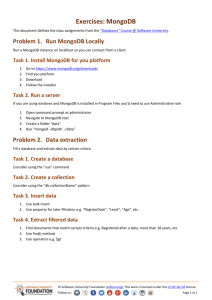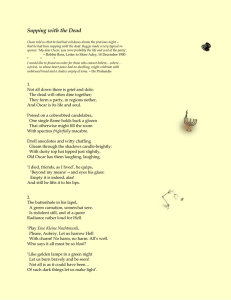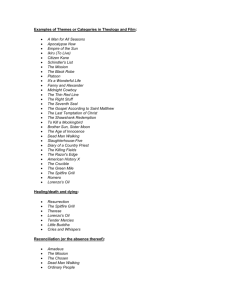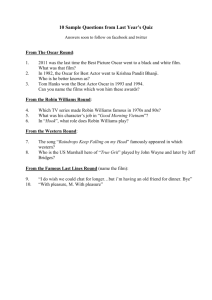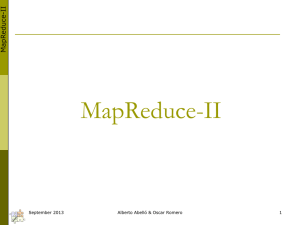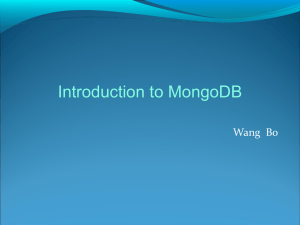Document Stores res to
advertisement
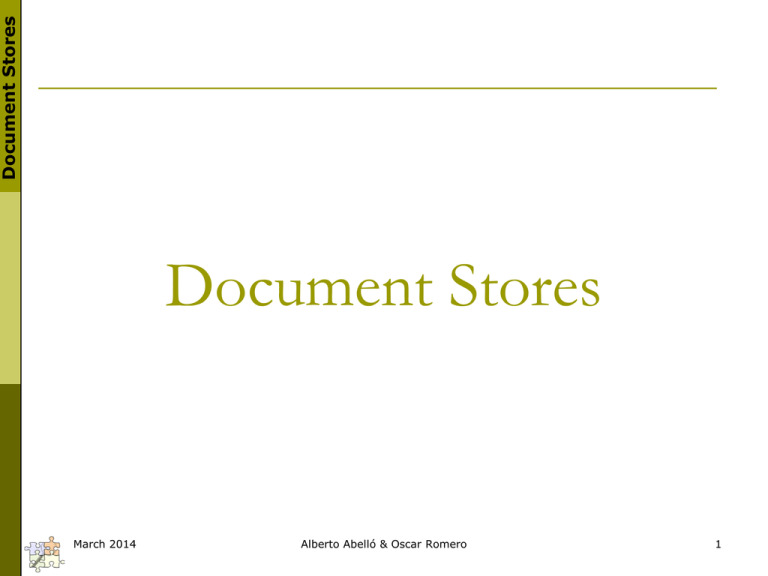
Document Stores
Document Stores
March 2014
Alberto Abelló & Oscar Romero
1
Document Stores
Knowledge Objectives
1.
2.
Explain the main difference between keyvalue and document stores
Justify why indexing is a first-class citizen
for document-stores and it is not for keyvalue stores
March 2014
Alberto Abelló & Oscar Romero
2
Document Stores
Application Objectives
1.
Given an application layout and a small
query workload, design a document-store
providing optimal support according to a
given set of criteria
March 2014
Alberto Abelló & Oscar Romero
3
Document Stores
Structuring the Value
Essentially, they are key-value stores
The value is a document
XML (e.g., eXist)
JSON (e.g., MongoDB and CouchDB)
Tightly related to the Web
Same design and architectural features
Normally, they provide RESTful HTTP APIs
So… what is the benefit of having
documents?
New data model (collections and documents)
New atom: from rows to documents
Indexing
March 2014
Alberto Abelló & Oscar Romero
4
Document Stores
Designing Document Stores
Follow one basic rule: 1 fetch for the whole
data set at hand
Aggregate data model: check the data needed by
your application simultaneously
Do not think relational-wise!
Use indexes to identify finer data granularities
Consequences:
Independent documents
Avoid pointing FKs (i.e., pointing at other docs)
Massive denormalization
A change in the application layout might be
dramatic
March 2014
It may entail a massive rearrangement of the database
documents
Alberto Abelló & Oscar Romero
5
Document Stores
JSON Document-Stores
JSON-like documents
MongoDB
CouchDB
JSON is a lightweight data interchange format
Brackets ([]) represent ordered lists
Curly braces ({}) represent key-value dictionaries
Keys must be strings, delimited by quotes (")
Values can be strings, numbers, booleans, lists, or keyvalue dictionaries
Natively compatible with JavaScript
Web browsers are natural clients
http://www.json.org/index.html
March 2014
Alberto Abelló & Oscar Romero
6
Document Stores
JSON Example
Definition:
A document is an
object represented
with an unbounded
nesting of array
and object
constructs
March 2014
Alberto Abelló & Oscar Romero
7
Document Stores
MongoDB: Data Model
Collections
Definition: A grouping of MongoDB documents
A collection exists within a single database
Collections do not enforce a schema
MongoDB Namespace: database.collection
Documents
Definition: JSON documents (serialized as BSON)
March 2014
Basic atom
Identified by _id (user or system generated)
Aggregated view of data
May contain
References (NOT FKs!) and
Embedded documents
Alberto Abelló & Oscar Romero
8
Document Stores
MongoDB: Document Example
March 2014
Alberto Abelló & Oscar Romero
9
Document Stores
MongoDB: Document Example
March 2014
Alberto Abelló & Oscar Romero
10
Document Stores
Activity
Objective: Learn how to model documents
Tasks:
(15’) Model the TPC-H using documents
2. (5’) Discussion
1.
SELECT l_orderkey,
sum(l_extendedprice*(1l_discount)) as revenue,
o_orderdate, o_shippriority
FROM customer, orders, lineitem
WHERE c_mktsegment = '[SEGMENT]'
AND c_custkey = o_custkey AND
l_orderkey = o_orderkey AND
o_orderdate < '[DATE]' AND
l_shipdate > '[DATE]'
GROUP BY l_orderkey,
o_orderdate, o_shippriority
ORDER BY revenue desc,
o_orderdate;
March 2014
Alberto Abelló & Oscar Romero
11
Document Stores
MongoDB Shell
Show dbs
Use <database>
Show collections
Show users
coll = db.<collection>
Find(criteria, projection)
Insert(document)
Update(query, update, options)
Save(document)
Remove(query, justOne)
Drop()
EnsureIndex(keys, options)
Notes:
db refers to the current database
query is a document (query-by-example)
http://docs.mongodb.org/manual/reference/mongo-shell/
March 2014
Alberto Abelló & Oscar Romero
12
Document Stores
MongoDB: Querying
Find and findOne methods
database.collection.find()
database.collection.find( { qty: { $gt: 25 } } )
database.collection.find( { field: { $gt: value1, $lt: value2 } } )
Aggregation Framework
An aggregation pipeline
Documents enter a multi-stage pipeline that transforms
them into an aggregated result
Filters that operate like queries
Document transformations that modify the form of the output
Grouping
Sorting
Other operations
MapReduce
March 2014
Alberto Abelló & Oscar Romero
13
Document Stores
MongoDB: The Aggregation Framework
March 2014
Alberto Abelló & Oscar Romero
14
Document Stores
MongoDB: Architecture
http://horicky.blogspot.com.es/2012/04/mongodb-architecture.html
March 2014
Oscar Romero
15
Document Stores
MongoDB: Storage
http://horicky.blogspot.com.es/2012/04/mongodb-architecture.html
March 2014
Oscar Romero
16
Document Stores
MongoDB: Fragmentation
Based on sharding (horizontal fragmentation)
Shard key: a mandatory field in all documents of
the collection
Chunk: Hash-based or range-based horizontal
fragmentation according to the shard key
Range-based: MongoDB determines the chunks by range
Adequate for range queries
Hash-based: Consistent hashing (a hash function
determines the chunks)
A Hash-indexed field is required
Vs.
March 2014
Oscar Romero
17
Document Stores
MongoDB: Notation
Shard clusters
Shards: Nodes containing data
A shard may contain several chunks
Config Servers: Nodes containing the global
catalog (e.g., hash directory)
Query routers: Nodes containing a copy of the
hash directory to redirect queries
March 2014
Oscar Romero
18
Document Stores
MongoDB: Shard Clusters Management
Query routers are replicas of the config servers
Secondary versioning (config servers)
Eager replication (to both config servers and query
routers)
Config Servers
The hash directory is mandatorily replicated to avoid
single-point failures
MongoDB asks for 3 config servers
Writes happen if:
2PCP (potential distributed deadlocks!)
A shard splits
A chunk migrates between servers (e.g., adding servers)
Query routers
Read from config servers
March 2014
When they start (o restart)
Every time a split / migration happens
Oscar Romero
19
Document Stores
MongoDB: Splitting/Migrating Chunks
Default chunk size: 64MB
The query router (mongos) asks a shard to split
Inserts and updates trigger splits
Shards rearrange the data (data migration)
During the migration requests to that chunk address
the origin shard
Changes made during the migration are afterwards
applied in the destination shard
Finally, changes in the hash directory are made in the
config servers
Query routers eagerly synchronized
A balancer avoids uneven distributions
March 2014
Oscar Romero
20
Document Stores
MongoDB: Replication
Each shard (in a shard cluster) is a replica set
Maps to a mongod instance (with its config servers)
One master
Replica Set: Master versioning with lazy replication
Several replicas
Write / Update / Delete
Reads
Replica Set management
The master has recovery system
Members interconnected by heartbeats
If the master fails, voting phase to decide a new master
Writes / Updates / Deletes and index modifications are kept in
memory (@master)
Specific recovery system (journaling): WAL redo logging
When the journal (i.e., log) is flushed to disk it is deleted
PAXOS (arbiters allowed)
If a replica fails, it catches up with the master once back
March 2014
Oscar Romero
21
Document Stores
MongoDB: Well-Known Limitations
Architectural Issues
Thumb rule: 70% of the database must fit in memory
Be careful with updates! (padding)
Holes caused by reallocation
Compact the database from time to time
Document Issues
The resulting document of an aggregation pipeline cannot
exceed the maximum document size (16Mb)
GridFS for larger documents
Attribute names are kept as they are (no catalog)
No transactions
Querying Issues
Consistency only guaranteed at document level
Strong / loose consistency parametrizable
Thumb rule: A query must attack a single collection
The aggregation capabilities are still rather immature
No optimizer!
March 2014
Oscar Romero
22
Document Stores
Summary
Document-stores
Semi-structured value
Indexing
Designing document-stores
MongoDB
March 2014
Alberto Abelló & Oscar Romero
23
Document Stores
Bibliography
S. Abiteboul et al. Web Data Management.
Cambridge University Press, 2012
E. Brewer. Towards Robust Distributed
Systems. PODC’00
D. Battre et al. Nephele/PACTs: A
Programming Model and Execution
Framework for Web Scale Analytical
Processing. SoCC’10
L. Liu and M.T. Özsu (Eds.). Encyclopedia
of Database Systems. Springer, 2009
March 2014
Alberto Abelló & Oscar Romero
24
Document Stores
Resources
https://www.mongodb.org
http://exist-db.org
March 2014
Alberto Abelló & Oscar Romero
25

